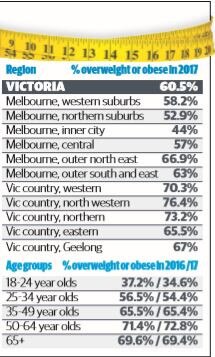Obesity rates in Australia show first drop in a decade
FOR the first time in a decade Australia’s increasing obese population appears to have shed some of its own excess but health experts are hesitant to celebrate just yet.

News
Don't miss out on the headlines from News . Followed categories will be added to My News.
FOR the first time in a decade Australia’s increasing obese population appears to have shed some of its own excess but health experts are hesitant to celebrate just yet.
Data collected for the latest Medibank Better Health Index indicated the rates of overweight or obese Australians dropped from 63 per cent to 62 per cent in 2017.
The results indicate 200,000 formerly overweight Australians would now be in a healthy weight range, however, it would take several more big data studies with similar findings for experts to confirm any trend.
OBESITY AND EATING DISORDERS SHARE RISK FACTORS
OBESITY PATIENTS A DRAIN ON REGIONAL MEDICAL CARE
CUT CARBS, BOOST PROTEIN, FATS TO PREVENT OBESITY
BABIES FROM POOR FAMILIES AT HIGHER RISK OF OBESITY

Medibank chief medical officer Linda Swan said Australia’s obesity rates remained at crisis levels, though the subtle change gave hope to those trying to ease the strain on the national health system.
“It is the first time we have seen a positive trend in 10 years, which is great news, but by no means are we saying the problem is solved and we can take our foot off the pedal,” Dr Swan said.
“It is hopefully a sign that all the things being done to try and raise awareness about obesity and the need to exercise are having an impact.

“Even if this was a consistent trend, it is really not happening fast enough. We are still going to have a very large burden of chronic disease impacted by the high number of people with extra weight.”
Inactivity, in particular, is a problem.
Conducted by Roy Morgan Research, the quarterly Medibank index interviewed more than 1000 Australians a week since 2007 to track the nation’s health status.

As well as a slight drop in number, the latest results also indicate Australia’s mean BMI score slipped from 27.44 in 2016 to 27.37 in 2017.
Victoria remains slightly slimmer than the national average, with 60.5 per cent of the state’s population overweight or obese.
However, there are still major differences in the health of regional and metropolitan areas, with poorer access to fresh food and limited recreational opportunities blamed in part for bigger waistlines in the bush.
On a more positive note, Dr Swan said the best results were in the younger generations.

“There has been a lot of programs run in schools to try and educate kids, so maybe we are seeing some of that paying off, maybe there is a cultural shift in the younger generations,” she said.
“There are lots of wonderful and free community activities you can get out and get involved in. It doesn’t have to be an expensive gym.”


